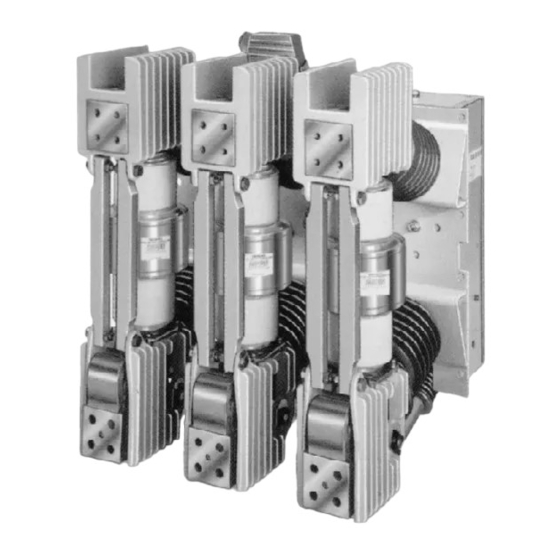Siemens 3AH Pengoperasian & Pemeliharaan Instalasi - Halaman 13
Jelajahi secara online atau unduh pdf Pengoperasian & Pemeliharaan Instalasi untuk Peralatan Industri Siemens 3AH. Siemens 3AH 20 halaman. Vacuum circuit breaker operator module
Juga untuk Siemens 3AH: Petunjuk, Pemasangan, Pengoperasian, Pemeliharaan (33 halaman), Petunjuk Manual (38 halaman)

Vacuum Interrupter/Operator Description
Construction
The essential parts of the operating mechanism are shown
in Figures 6a and 6b. The control and sequence of operation
of the mechanism is described in Figure 8.
Motor Operating Mechanism (Figure 6a)
The spring charging motor (50.4) is bolted to the charging
mechanism (50.2) gear box installed in the operator housing.
Neither the charging mechanism nor the motor require any
maintenance.
Mode of Operation
The operating mechanism is of the stored-energy trip free
type, i.e., the charging of the closing spring is not automati-
cally followed by the contacts changing position, and the
closing function may be overridden by an opening com-
mand at any time.
When the stored-energy mechanism has been charged, the
instant of operation can be chosen as desired.
The mechanical energy for carrying out an "open-close-
open" sequence for auto-reclosing duty is stored in the clos-
ing and opening springs.
Charging
The details of the closing spring charging mechanism are
shown in Figure 6a. The charging shaft is supported in the
charging mechanism (50.2), but is not coupled mechani-
cally with the charging mechanism. Fitted to it are the crank
(62.2) at one end, and the cam (62.3), together with lever
(62.5), at the other.
When the charging mechanism is actuated by hand with
a hand crank (Figures 9a and 9b) or by a motor (50.4), the
flange (50.3) turns until the driver (50.3.1) locates itself in
the cutaway part of the cam disc (62.3), thus causing the
charging shaft to follow. The crank (62.2) charges the closing
spring (62). When the closing spring has been fully charged,
the crank actuates the linkage (55.1) via the control lever
(55.2) for the "closing spring charged" indicator (55), and
actuates the limit switches (50.4.1) for interrupting the motor
supply. At the same time, the lever (62.5) at the other end
of the charging shaft is securely locked by the latching pawl
(62.5.2). When the closing spring is being charged, cam disc
(62.3) follows idly, i.e., it is brought into position for closing.
Closing (Figures 6a, 6b and 7a - 7d)
If the circuit breaker is to be closed locally, the closing spring
is released by pressing the CLOSE button (53). In the case
of remote control, the close coil 52SRC (53.1) unlatches the
closing spring (62).
As the closing spring discharges, the charging shaft (62.1) is
turned by crank (62.2). The cam disc (62.3) at the other end
of the charging shaft actuates the drive lever (62.6), with the
result that jack shaft (63) is turned by lever (63.5) via the trip
free coupling rod (62.8). At the same time, the levers (63.1),
(63.5) and (63.7) fixed on the jack shaft operate the three in-
sulating couplers (48) (Figure 5 ) for the circuit breaker poles.
Lever (63.7) changes the Open-close indicator (58) over to
Open. Lever (63.5) charges the opening spring (64) dur-
ing closing, and the circuit breaker is latched in the closed
position by lever (64.3) with pawl roller (64.3.1) and by pawl
(64.2). Lever (63.1) actuates the auxiliary switch (68) through
the linkage (68.1).
The crank (62.2) on the charging shaft (62.1) moves the link-
age (55.1) by acting on the control lever (55.2). The closing
spring charged indication is thus canceled, and the limit
switches (50.4) switch in the control supply to cause the
closing spring to recharge immediately.
Trip Free Operation (Figures 6a and 6b)
The trip free coupling rod (62.8) permits the immediate
decoupling of the drive lever (62.6) and the jack shaft (63) to
override closing action by trip command or by means of the
racking interlocks.
The trip free coupling rod (62.8) forms a link between the
drive lever (62.6) and the jack shaft (63). The rigidity of this
link depends upon a spring return latch (62.8.1) carried
within the coupling rod. The latch pivots within the coupling
rod and is normally positioned to ensure the rigidity of the
coupling rod. Trip free coupling link (62.8.2) and trip free
coupling lever (62.8.3) cause the spring return latch posi-
tion to be dependent upon the normal tripping components
and the racking interlock. Thus, whenever a trip command is
applied or the circuit breaker is not in the fully CONNECT or
TEST position, the trip free coupling rod is no longer rigid,
effectively decoupling the drive lever and jack shaft. Under
these conditions the vacuum interrupter contacts cannot be
closed.
Opening (Figure 6a)
If the circuit breaker is to be opened locally, the opening
spring (64) is released by pressing the Open pushbutton
(54). In the case of an electrical command being given, the
trip coil 52T (54.1) unlatches the opening spring (64).
The opening spring (64) turns the jack shaft (63) via lever
(63.5); the sequence being similar to that for closing.
11
